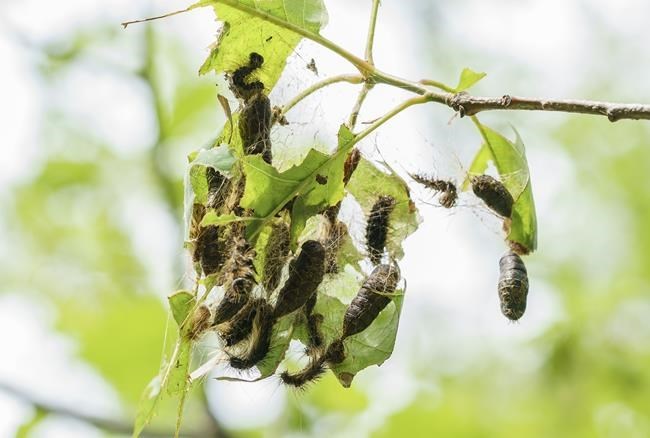MONTREAL — Biologists are tracking a bumper crop of hungry caterpillars that are eating their way through some of Quebec and Ontario's best-known green spaces, raining down excrement on the forest floor and leaving bald, leafless trees in their wake.
The gypsy moth caterpillars have been especially present on Montreal's Mount Royal, where almost all the large oaks at the summit have lost half or more of their leaves, according to a group dedicated to protecting the mountain.
"It's something we've never seen on this level," Antonin St-Jean, with Les amis de la montagne, said in an interview Wednesday, adding that while the deforestation is unsightly, there's little the group can do.
André-Philippe Drapeau Picard, an entomologist with the Montreal Insectarium, says the caterpillar's population tends to rise and fall in cycles, and that mild temperatures last winter likely contributed to higher-than-average numbers this year. The caterpillars, he added, don't usually cause permanent damage to healthy trees but can impact those that were already sick or weak.
Besides, this year's onslaught is almost over: in the coming days, the caterpillars will stop eating leaves as they begin to transform into large brown moths. "Healthy trees will be able to make new leaves once the caterpillars will transform into chrysalids and ultimately moths," Drapeau Picard said in an interview Tuesday.
"On the other hand, if the trees are already sick, or there is an outbreak at the same time as a drought, it could represent a danger."
The moths are most common in southern Quebec, eastern Ontario and the Atlantic provinces. Drapeau Picard said he was surprised to have spotted them two weeks ago in the lower St. Lawrence region, which is further east than he's seen them in Quebec before.
The moth was first brought to North America in the late 19th century by Europeans who hoped to use them to produce silk, he said. Since then, the animal has become invasive.
While biologists and the Canadian government still use the term "gypsy moth," some groups have switched to using the name LDD — an abbreviation of Lymantria dispar dispar — out of concerns the name could be seen as culturally insensitive.
James Pagé, a biodiversity specialist with the Canadian Wildlife Federation, says the small, hairy caterpillars have been visible in Ontario this year, including some "big infestations" around Ottawa's greenbelt. "It sounds like rain from the droppings of the caterpillar throughout the forest, so it's not a pleasant feeling to be out in the woods and knowing that's what's falling from the trees," he said in an interview Wednesday.
Pagé said his group is working with the federal government to track the spread of the invasive moth with the help of the public. He's encouraging people who spot the caterpillars and moths to report their sightings on the Canadian iNaturalist website so experts can track their populations and see if they're expanding outside their traditional range.
So far, he said sightings of the caterpillars and moths on iNaturalist have roughly doubled this year compared to last, although he said this could be explained in part by the site's growing popularity.
The Canadian Food Inspection Agency, which is responsible for monitoring invasive pests, has signalled that it is working to limit the spread of the moth. In March, the agency said in a notice it was increasing its inspection, monitoring and reporting requirements for nurseries that ship plants from areas where the moth is present to those where it isn't. The agency is also working with the Canadian Wildlife Federation and iNaturalist, Pagé said.
Drapeau Picard and St-Jean said that while cities aren't taking large-scale action to control the pest, people can always protect their own individual trees by putting up sticky barriers to trap caterpillars and by removing eggs once they appear.
This report by The Canadian Press was first published July 7, 2021.
Morgan Lowrie, The Canadian Press



